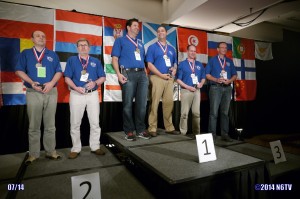USA Teams finish 1st and 4th, Slovakia and Germany get medals
WESTBOROUGH, MA Issued July 15, 2014…The award winners for the 2014 World Radiosport Team Championship (WRTC2014) were announced at a ceremony July 14 at the conclusion of the event. A team from the USA earned the gold medal, with teams from Slovakia and Germany getting silver and bronze.
The US team of Dan Craig, N6MJ, and Chris Hurlbut, KL9A, operating with the callsign K1A, took home the gold for their winning effort. Their final score after log checking was 7,184,844 points. There was little suspense about the top spot; Craig and Hurlbut had led the 59 competing teams from the first hour. Craig, 33, of Rancho Cucamonga, California, comes from a ham radio family and got his license when he was just 8 years old. He had competed in the last three WRTCs, finishing fourth in 2002, second in 2006, and third in 2010. Hurlbut, 31, of Bozeman, Montana, became a ham when he was 10 and began contesting 4 years later. A number of family members were hams including his great grandfather, grandfather, father, and uncle. Hurlbut competed in WRTC-2006 as the partner of N0AX.
Walking away with the silver was the Slovakia team of Rastislav Hrnko, OM3BH, and Jozef Lang, OM3GI, who operated as W1L and achieved 6,816,144 points. Hrnko, 46, got into ham radio when he was 11. Lang, who’s 54, was licensed at 15. Both are active members of the OM8A contest team. This is the third time to compete in WRTC for Hrnko and Lang. They were also teammates at WRTC-2000 in Slovenia and WRTC-2010 in Russia.
The team of Manfred Wolf, DJ5MW, and Stefan von Baltz, DL1IAO, operating as W1P, won the bronze medal with 6,421,383 points. Wolf, 42, received his first Amateur Radio license at age 15. This was his second time competing at WRTC; the first was WRTC-2000 in Slovenia. Von Baltz, 38, was first licensed at age 14. This was his fourth time to compete at WRTC. Previous attempts were in 1996 and 2002 with DK3GI and in 2000 with DJ5MW.
The winner of the bronze medal was not easily determined. The third through fifth place scores were so close that it took the judging committee working overnight to determine the order of finish.
Chief Judge David Sumner, K1ZZ, who was master of ceremonies for the awards presentations, said there was “a lot of pressure” on the judges to get it right, and they had to carefully scrutinize the logs of those placing the third, fourth, and fifth in the claimed scores. “Because the skills of the operators were so high, the judges had a very, very difficult time resolving the position for number 3,” Sumner told the gathering. “In the end, there were 8000 points separating number 4 from number 3. That’s six-tenths of a multiplier.”
Wolf and von Baltz edged out fourth-place finishers Kevin Stockton, N5DX, and Steve London, N2IC, both from the US, who garnered 6,413,056 points operating as W1Z.
In addition to the medals, awards were issued for most SSB (voice) contacts, most CW (Morse code) contacts, highest multiplier, and most accurate entry. The SSB and CW awards require teams to work at least 35% of their contacts on the other mode to promote demonstration of both skills.
The winner of the SSB award was the Italian team of K1M operated by Carlo De Mari, IK1HJS and Fabio Schettino, I4UFH with 2063 voice contacts and 1233 on CW. They entered the competition with the goal of winning the SSB award.
The CW award was a bit of a surprise due to the 35% rule. The winning CW team was by Philippe Lutty, LX2A, from Luxembourg and Andy Ruse, YO3JR, from Romania. Operating with the callsign N1S, they had 2391 contacts on CW and 1302 on SSB. There were other teams with more CW contacts, but did not achieve the required 35% ratio of SSB contacts. Lutty focused on SSB during the competition and Ruse did most of the work on CW.
The award for highest multiplier went to the gold medal team of Craig and Hurlbut. It is unusual for the team with the most contacts to also have the highest multiplier since there is usually a tradeoff between working stations quickly on one frequency or tuning to find new countries or IARU headquarter stations. Their 436 total multipliers was well ahead of the second highest multiplier of 422 by Hrnko and Lang.
The accuracy award was won by the bronze medal team of Wolf and van Baltz. The duo of Wolf and von Baltz had ranked fifth in the “raw claimed scores” posted on the scoreboard at the end of the competition. With only a 1% error rate, they moved up past two other teams to win the bronze medal. Accuracy measures the ability of the teams to copy callsigns and exchanges without errors. Errors result in penalties that lower the final score.
According to Chief Judge Sumner, “As a matter of fact, had we not checked to the depth that we did, the error rate at W1P would actually have been a bit lower.”
Full results for all 59 teams is available at http://www.wrtc2014.org/results/
About WRTC2014
The World Radiosport Team Championship (WRTC) is held every four years and consists of 50+ two-person teams of amateur radio operators from around the world competing in a test of operating skill. Unlike most on-the-air competitions, all stations are required to use identical antennas from the same geographic region, eliminating all variables except operating ability. Previous WRTCs have been held in Seattle (1990), San Francisco (1996), Slovenia (2000), Finland (2002), Brazil (2006), and Russia (2010). More information is available at www.wrtc2014.org or contact WRTC Chairman Doug Grant, K1DG, via e-mail at k1dg@wrtc2014.org.
The location of the next World Radiosport Team Championship scheduled for July 2018 has not yet been determined.

